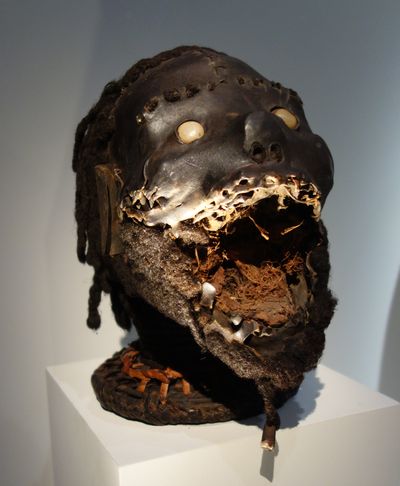Ejagham crest mask with a human head
![Ejagham crest-mask with a human head. Cross River region, Nigeria, 19th century. Quai Branly Museum [2163x2753] : r/ArtefactPorn](https://i.redd.it/rk1npj43a5c71.jpg)
Date: 19th c.
Geography: Cross River region, Nigeria.
Materials: Human skull, antelope skin, basketry, lead, hair.
Quai Branly Museum, Paris, France.

Masks of this kind are usually covered in antelope skin, but rare examples covered in human skin have led researchers to hypothesize that warriors originally wore the heads of killed enemies. The masks are thus believed to symbolize the appropriation of enemies’ power.

Ekoi people, also known as Ejagham, are a Bantoid ethnic group in the extreme south of Nigeria and extending eastward into the southwest region of Cameroon. They speak the Ekoi language, the main Ekoid language. Other Ekoid languages are spoken by related groups, including the Etung, some groups in Ikom (such as Ofutop, Akparabong and Nde), some groups in Ogoja (Ishibori and Bansarra), Ufia and Yakö. The Ekoi have lived closely with the nearby Efik, Annang, Ibibio and Igbo people of southeastern Nigeria. The Ekoi are best known for their Ekpe headdresses and the Nsibidi text. They traditionally use Nsibidi ideograms, and are the group that originally created them

Related Post
A shocking documentary proves that mermaids do exist
SHOCKING Revelation: Thuya, Mother of Queen Tiye, Was the Grandmother of Akhenaten and Tutankhamun—What Ancient Egyptian Secrets Did She Leave Behind?
Breaking News: Astonishing Discoveries at Karahan Tepe Confirm an Extraterrestrial Civilization is Hiding on Earth, and NO ONE Knows!
Breaking News: Researchers FINALLY Discover U.S. Navy Flight 19 After 75 Years Lost in the Bermuda Triangle!
NASA’s Secret Investigation: Uncovering the Astonishing Mystery of the UFO Crash on the Mountain!
Explosive UFO Docs LEAKED: Startling Proof That Aliens Ruled Ancient Egypt!